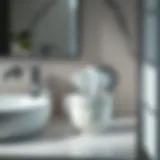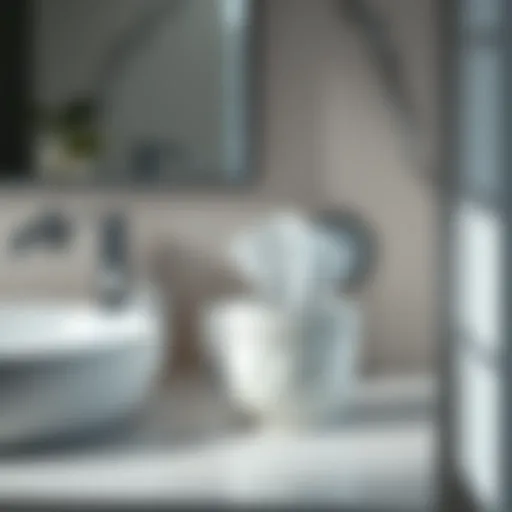Understanding Black Mold in the Bathroom: Causes & Solutions
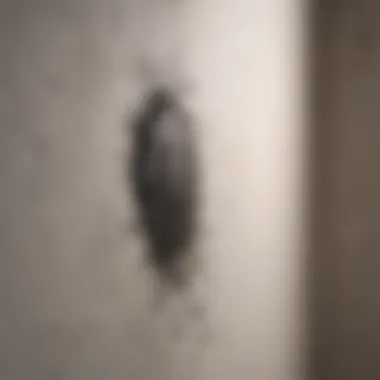

Intro
Black mold, scientifically termed Stachybotrys chartarum, is not just an aesthetic concern in bathrooms. It can pose significant health risks and indicate larger issues related to moisture and ventilation. The presence of black mold can lead to various health complications, particularly for individuals with respiratory conditions or weakened immune systems.
This article delves deep into understanding black mold in bathrooms. It will cover its causes, potential health risks, methods for detection, and effective remediation strategies. Homeowners and renters alike will find practical solutions for preventing mold growth. Furthermore, we will discuss moisture control and ventilation, essential elements for maintaining a safe and clean living environment. The goal is to equip readers with knowledge and strategies that foster a mold-free space.
Key Points to Discuss:
- Causes of black mold in bathrooms
- Health implications of mold exposure
- Techniques for detecting mold
- Effective removal strategies
- Importance of moisture control and proper ventilation
With this foundation, we will move forward to explore these aspects in detail, ensuring a comprehensive understanding of the nature of black mold and how to manage it effectively.
Prolusion to Black Mold
Understanding black mold is vital for maintaining a healthy living environment, especially in bathrooms where moisture is often prevalent. This section aims to outline critical elements of black mold, its characteristics, and its common types. Homeowners need to grasp the significance of identifying these molds early to prevent extensive damage to property and negative health effects.
Definition and Characteristics
Black mold, primarily known as Stachybotrys chartarum, is a type of fungus that can thrive in damp areas. It appears as a black or dark green stain on surfaces, often emitting a musty odor. Mold can reproduce through tiny, lightweight spores that travel through air. Exposure can occur without visible signs; hence, understanding its characteristics is essential for recognition and early intervention. Mold requires moisture, organic material, and restricted air circulation to flourish, making bathrooms particularly susceptible.
Common Types of Mold Found in Bathrooms
Several types of mold can proliferate in bathrooms, each with distinct properties:
- Aspergillus: This mold can appear in various colors. While often non-toxic, it can cause respiratory issues.
- Penicillium: Recognizable by its bluish-green color, it generally grows on damp walls or ceilings.
- Cladosporium: This mold may appear as olive-colored spots. It can thrive on both wet and dry surfaces.
Identifying these types reinforces the importance of regular bathroom maintenance. Keeping the area clean and dry significantly reduces the risk of mold infestation.
"Regular inspection and cleaning are crucial in preventing the growth of black mold in bathrooms. "
Causes of Black Mold Growth
Understanding the causes of black mold growth in bathrooms is essential for effective prevention and management. Black mold thrives in damp, warm environments, making bathrooms particularly vulnerable. This section will delve into the specific factors that contribute to mold proliferation, offering insights that every homeowner and renter should be aware of. Addressing these causes not only helps in keeping living spaces safe but also promotes a healthier home environment.
Moisture and Humidity Issues
Moisture plays a direct role in the growth of black mold. Bathrooms are often subjected to high levels of humidity due to activities such as showering and bathing. When steam and water vapor accumulate, they can create the perfect conditions for mold to develop on surfaces such as walls, ceilings, and grout.
It is important to monitor humidity levels in the bathroom. Ideally, humidity should be kept below 60% to deter mold. Homeowners can employ dehumidifiers or air conditioners to reduce moisture content in the air. Additionally, it's beneficial to wipe down surfaces after use to minimize water accumulation. Regularly inspecting for any damp patches in corners or behind fixtures can also assist in early detection of potential mold growth.
Poor Ventilation
Inadequate ventilation significantly contributes to the presence of black mold. Bathrooms often contain limited windows or airflow, which prevents moist air from escaping. Poor ventilation traps humidity, leading to an increase in mold spores.
To enhance ventilation, consider installing exhaust fans that vent air outside the home. Keeping bathroom doors open during and after baths or showers can also improve air circulation. If possible, choose to leave windows open for natural airflow or use exhaust fans continuously for at least 20 minutes after bathing. Creating an environment with better airflow can greatly reduce moisture levels and subsequently the risk of mold.
Water Leaks and Plumbing Failures
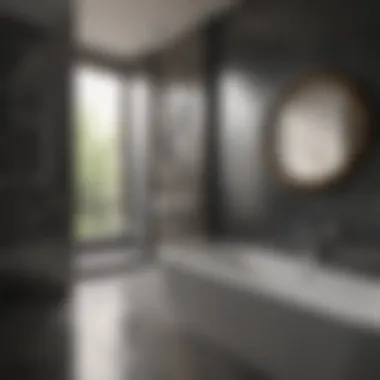

Leaks from plumbing fixtures can be a hidden source of moisture, contributing to black mold growth. This includes faucet leaks, showerhead drips, and even toilet leaks. If left unchecked, these leaks can lead to persistent damp conditions, encouraging mold development.
Regularly inspecting plumbing systems is crucial. Homeowners should look for signs of leaks, such as dark stains on walls or ceilings, or check under sinks for puddles. If a leak is detected, it must be repaired promptly. Additionally, sealing any gaps around plumbing fixtures can help prevent moisture ingress. Ensuring that all plumbing components function correctly plays an important role in mold prevention.
Identifying Black Mold in the Bathroom
Identifying black mold in the bathroom is a crucial step in managing this common household issue. Awareness of the early signs and knowledge about the specific characteristics of black mold can help prevent potential health risks associated with its presence. This section will explore essential elements in identifying black mold and the benefits of swift recognition.
Visual Signs to Look For
Recognizing visual signs of black mold requires careful observation. Black mold typically appears as dark spots or patches, often found in damp locations like around faucets, showers, and toilets. It can also grow on tiles, drywall, and grouting. Notably, the texture of black mold can be fuzzy or slimy, significantly differing from other common household molds.
Here is a list of visual signs to be vigilant about:
- Dark, black or greenish spots on surfaces
- A musty or damp appearance on walls or ceilings
- Water stains or discoloration around plumbing fixtures
- Peeling paint or wallpaper in moisture-prone areas
It's important to take immediate action upon sighting these signs, as the mold can spread quickly if left unchecked.
Smell and Air Quality Indicators
Mold often emits a distinct odor, which is very different from typical household smells. If you notice a musty or earthy smell in your bathroom, it could indicate the presence of mold, even if it is not visually apparent yet. This odor is caused by the volatile organic compounds that certain types of mold release into the air.
To assess air quality, consider the following:
- Any unusual odors that seem to linger, especially after prolonged dampness
- Symptoms like sneezing, coughing, or a runny nose when in the bathroom
If these air quality indicators are present, further investigation into potential mold presence may be warranted.
Testing for Mold Presence
While visual inspection and smell tests are helpful, some situations may require testing to confirm mold presence. Professional mold testing can identify the specific type of mold and its concentration in the air and materials. DIY testing kits are also available for homeowners who wish to conduct their own assessments.
Considerations for testing include:
- The type of testing kit chosen, such as air sampling or surface sampling
- Following the manufacturer's instructions carefully for accurate results
- Consulting a professional, especially if significant mold growth is suspected
Identifying black mold accurately is essential to maintain a safe and healthy living environment. Prompt recognition allows for appropriate measures to be taken, safeguarding the well-being of all occupants.
Health Implications of Black Mold Exposure
Understanding the health implications of black mold exposure is essential for homeowners and renters alike. Black mold, specifically Stachybotrys chartarum, can pose significant risks to both physical and mental well-being. The presence of this mold in bathrooms or any other part of the home can lead to serious health concerns, especially for vulnerable individuals. Awareness of these implications promotes timely action and effective prevention strategies.
Common Symptoms of Exposure
Exposure to black mold can trigger a range of symptoms that vary in severity and type. Common symptoms include:
- Respiratory Issues: Coughing and wheezing are frequent complaints. Individuals with asthma may notice their symptoms worsening.
- Skin Irritation: Rashes or eczema may develop. Direct contact can exacerbate these conditions.
- Allergic Reactions: Sneezing, runny nose, or itchy eyes can occur. Some might experience heightened sensitivity.
- Fatigue and Headaches: Unexplained fatigue or frequent headaches may result from prolonged exposure.
- Neurological Effects: In rare cases, cognitive effects such as difficulty concentrating have been noted.
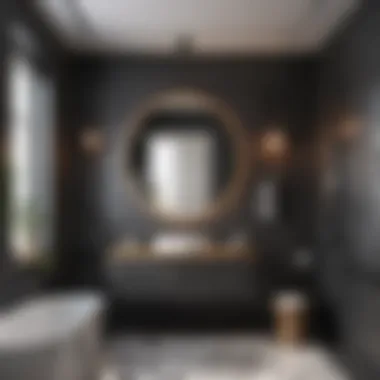

If these symptoms appear and the presence of black mold is suspected, it is advisable to consult a healthcare professional. Early diagnosis can mitigate long-term effects.
At-Risk Populations
Certain groups are at a higher risk when it comes to exposure to black mold. Some of these populations include:
- Children: Their immune systems are still developing, making them more susceptible to mold-related issues.
- Elderly Individuals: Aging bodies often have compromised immune responses, leading to increased vulnerability.
- Pregnant Women: Hormonal changes and stress on the body during pregnancy can lead to heightened sensitivities.
- People with Preexisting Conditions: Those with respiratory illnesses, allergies, or weakened immune systems face greater risks from mold exposure.
Prolonged exposure to black mold can lead not only to physical ailments but also to mental health challenges.
Being vigilant about black mold in bathrooms and taking preventative measures can significantly lessen health risks. Ensuring immediate action upon finding any mold can protect those who are most vulnerable.
Preventing Black Mold in the Bathroom
Preventing black mold in the bathroom is crucial for maintaining a healthy living environment. Bathrooms are naturally humid areas, making them a prime target for mold growth. Understanding how to effectively mitigate moisture and improve ventilation can significantly reduce the likelihood of black mold proliferation. This not only safeguard's the health of individuals but also protects the integrity of the home itself. With the right practices in place, homeowners can avoid costly remediation efforts and foster a safe, clean atmosphere.
Effective Moisture Control Methods
Moisture control is essential in preventing black mold. Several effective methods can keep the bathroom dry:
- Use a Dehumidifier: Employ a dehumidifier to remove excess moisture from the air, especially in bathrooms with no windows.
- Install Moisture-Resistant Materials: Utilize materials that resist moisture, such as tiles and fiberglass. Paint with mold-resistant formulations is also beneficial.
- Keep Surfaces Dry: After baths or showers, wipe down surfaces with a towel. Pay special attention to sinks and countertops.
These steps actively inhibit mold growth by eliminating water sources.
Enhancing Bathroom Ventilation
Proper ventilation is key to reducing humidity. Improving airflow can create an inhospitable environment for mold:
- Install an Exhaust Fan: A well-placed exhaust fan can efficiently expel moist air. It should be vented outside, not into the attic.
- Open Windows When Possible: Fresh air circulation helps lower humidity levels. Even a few minutes of open windows can make a difference during warmer months.
- Keep Doors Open: Leaving bathroom doors open after use allows for air circulation, contributing to drier conditions.
Implementing these ventilation strategies can complement moisture control efforts.
Regular Maintenance Practices
Routine maintenance prevents mold growth. Keeping a schedule can help ensure proactive care is not neglected:
- Inspect for Leaks: Regularly check plumbing fixtures for leaks. Address issues promptly to prevent water accumulation.
- Clean Regularly: Use mold inhibitors in cleaning agents. Regular scrubbing of tiles and grout can remove early signs of mold.
- Check for Condensation: Monitor areas prone to condensation, like mirrors and windows. Use moisture-absorbing materials if necessary.
Maintaining these practices creates an ongoing defense against mold.
Important Note: By taking proactive steps in moisture control, ventilation, and maintenance, homeowners can diminish the probability of black mold establishment in their bathrooms. Being vigilant is the key to ensuring a safe living space.
Remediation Steps for Black Mold
Remediating black mold is a critical process for maintaining a healthy environment in any bathroom. Failure to address mold growth can lead not only to structural damage but also to significant health issues for occupants. The focus of this section is to outline practical steps that can be taken towards effective remediation. Special attention will be given to safety precautions, DIY techniques, and when to consider professional help.
Safety Precautions Before Remediation
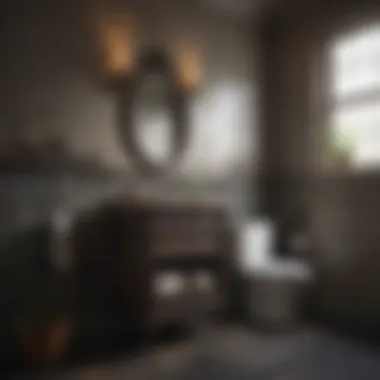

Before initiating any remediation work, ensuring safety is paramount. The first step involves wearing appropriate protective gear. Essential items include gloves, goggles, and a mask designed to filter out mold spores. This gear protects against inhalation and skin contact, which can lead to allergic reactions or other health problems.
Proper ventilation of the area is equally important. Open windows and doors to allow fresh air circulation. In cases where natural ventilation is not feasible, using fans can help move contaminated air away. If the moldy area is extensive, it may be wise to turn off the heating or cooling systems to reduce cross-contamination, as spores can spread through these systems.
Keep children and pets away from the area during remediation to avoid health risks. Have a plan to contain the mold spores by using plastic sheeting to seal off the working area. This minimizes further exposure to unprotected individuals.
DIY Removal Techniques
Removing black mold can sometimes be done with DIY methods, especially in small areas. It's essential to identify the right products for this task. Many homeowners choose a mixture of water and vinegar because it is effective and less toxic. A 1:1 ratio of vinegar and water can be applied directly to the affected area using a spray bottle.
Another option is using a solution containing bleach. Mix one cup of bleach with one gallon of water. Apply this mixture to the moldy surface and allow it to sit for at least 10 minutes before scrubbing. Always ensure the area is well-ventilated when using bleach.
After scrubbing the area, rinse with clean water and dry thoroughly to prevent future mold growth. It is important to note that porous materials, such as drywall or carpet, may need to be replaced rather than cleaned, as mold can penetrate these materials.
Professional Mold Remediation Services
In cases where mold infestation is severe or widespread, enlisting professional mold remediation services becomes necessary. Professionals have access to specialized equipment and expertise that can effectively assess and remediate mold issues. They conduct thorough inspections to identify hidden mold locations that may not be visible to the untrained eye.
Professionals use advanced technology such as infrared cameras to detect moisture and mold growth behind walls or under flooring. This thorough approach ensures that the mold is entirely removed, reducing the chance of recurrence. Moreover, hiring professionals provides peace of mind, knowing the job will be done correctly and safely.
Post-Remediation Considerations
Post-remediation considerations are essential to ensure that black mold does not return after removal. After tackling the immediate problem, it is crucial to evaluate the effectiveness of the remediation and establish preventive measures. Homeowners should not underestimate the significance of this phase, as it holds the key to long-term health and safety within the bathroom.
Verifying Mold Removal Effectiveness
The first step post-remediation is verifying that mold removal was successful. This process involves several methods. One common approach is visual inspection. Homeowners should check for any visible signs of mold or moisture in the bathroom. Pay extra attention to corners, behind fixtures, and any previously affected areas.
Additionally, conducting air quality tests can provide insights. There are home testing kits available that allow you to sample the air for spores. If these tests reveal residual mold spores, further action will be needed.
It may also be prudent to seek help from a professional mold inspector. Experts utilize more advanced testing equipment to measure air quality and ensure all traces of mold are eliminated. Investing in this service can provide peace of mind and help protect your health.
Long-Term Preventative Measures
After confirming effective mold removal, attention must shift to preventing future growth. Here are some critical measures for homeowners:
- Control Humidity: Use dehumidifiers to maintain indoor humidity levels below 60%.
- Ensure Proper Ventilation: Install exhaust fans or open windows during and after showers to reduce moisture buildup.
- Regular Cleaning: Use mold-inhibiting cleaners regularly on bathroom surfaces, particularly in high-moisture areas like showers and sinks.
- Inspect for Leaks: Regularly check plumbing for leaks and repair them promptly to avoid water accumulation.
Implementing these strategies creates an environment that is less conducive to mold growth. Homeowners must remain vigilant and proactive in their efforts, as mold can recur if conditions permit.
"Prevention is always better than cure."
By recognizing the significance of post-remediation considerations and taking appropriate steps, homeowners can maintain a safe, healthy bathroom environment.
Closure
In this article, we have thoroughly examined the issue of black mold in bathrooms, covering various aspects crucial for understanding and managing this problem. Black mold not only affects the aesthetics of a home but also carries potential health risks for occupants. Therefore, it is essential for homeowners and renters alike to be well-acquainted with prevention, identification, and remediation methods.
Key Takeaways on Black Mold Management
- Prevention is Key: Effective moisture control and good ventilation are paramount. Regularly check for leaks and ensure that your bathroom is well-ventilated to minimize humidity.
- Regular Maintenance: Routine cleaning with mold-inhibiting products can markedly reduce the chance of mold growing. This includes not just cleaning surfaces but also inspecting hidden areas like under sinks and behind shower curtains.
- Identification: Recognizing the visual signs of black mold and understanding the musty smells associated with its presence can lead to quicker action and reduce health risks.
- Health Considerations: Be aware that certain populations, including children and individuals with respiratory conditions, are more susceptible to the adverse effects of mold exposure.
- Remediation Steps: If mold is found, follow safety precautions during removal, which may include wearing protective gear, utilizing DIY methods, or hiring professional mold remediation services if the infestation is severe.
- Post-Remediation: After dealing with black mold, verifying its removal and implementing long-term preventive measures are crucial steps to ensure the issue does not resurface.
In summary, understanding the causes, implications, and management strategies surrounding black mold in bathrooms can lead to a healthier living environment. Engaging with the subject matter in a proactive manner empowers individuals to effectively mitigate risks associated with black mold.


